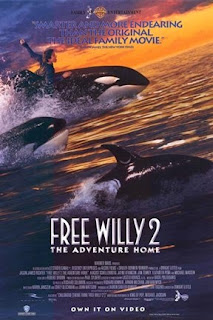The Land Before Time 1988, Dinosaur 2000, Flintstones: The Movie 1994, Jurassic Park 1993, and Jurassic Park lll 2001
No dinosaur marathon is complete without the first Jurassic Park included in it. With the premiere of Jurassic World closing in, there's no better and appropriate time than to explore the origins of dinosaurs and the controversy over whether both dinos and humans lived simultaneously. Movies like The Flintstones and Jurassic Park demonstate the parallels of dinosaurs and humans coexiting with one showing them getting along in their natural environments, and the other has the dinosaurs roaming free in a century they have no idea of, and becoming aggressive. The first movie of the evening is the 1988 children's classic titled The Land Before Time. The story centers around an orphaned brontosaurus teaming up with young dinosaurs in an effort to reunite with their families in a valley. Originally Steven Spielberg and George Lucas decided on not having any dialogue for the film, but changed their minds when they realized they wanted kids to be able to see the film. The next film in the dinosaur lineup is Disney's 2000 blockbuster titled Dinosaur. Grossing 137 million domestically upon it's release in May 2000, Dinosaur centers around an orphaned dinosaur joining a dificult journey to a sancturary after his families home is destroyed by a meteorite. The first two films center around the perspective of the dinosaurs, with the next three films showcasing the interaction between dinosaurs and humans. The third film in the lineup is the Steven Spielberg executive produced blockbuster The Flintstones. Starring John Goodman and Rick Moranis in the title roles of Fred Flinstone and Barney Rubble, the story centers around Fred Flintstone finally getting the job he always wanted but only after his best friend swapped tests with him after realized Fred had the worst score out of everyone. Once Fred gets into his comfortable new job as vice president at Slate and Company, he unravels a web of corruption being performed within the company by an executive named Cliff, whose using Fred as the fall guy for an embezzlement scheme. The Flintstones was a box office success in 1994, but opened to mostly negative reviews, with criticisms stemming from it failed to properly capture the humor of the show even though the casting for the film is stunning. It also serves as the first parallel to Jurassic Park in regards to humans and dinosaurs coexisting. The film shows numerous scenes where dinosaurs have become apart of human nature, and work off each other for survival. It's a great representation of The Land Before Time meets the stone age. The fourth film in the marathon is the critically acclaimed blockbuster and Steven Spielberg classic titled Jurassic Park. An adventure 65 million years in the making, this unforgettable masterpiece has a group of the world's greatest paleontologists and dinosaur experts coming to tour a new amusement park full of live dinosaurs that were created through DNA cloning. During the middle of the tour, the theme parks power shuts down allowing it's cloned dinosaurs to run rampant throughout the park, and hunt the few remaining humans left on the island. Winner of three academy awards including best visual effects, Jurassic Park matches it's groundbreaking technology with it's powerful set of characters such as Dr. Grant played by Sam Neil, Dr. Ian Malcom played by Jeff Goldblum, Laura Dern as Dr. Saddler, Richard Attenborough as John Hammond, Samuel Jackson as Ray Arnold, and Wayne Knight as the bumbling yet slimy character named Dennis. Spielberg's powerful trademark style of directing carries this one into the realm of being among the all time great films. The fifth and final movie of the night serves as a conclusion to the powerful story structure set up by Jurassic Park and the other dinosaur films. Joe Johnston's Jurassic Park lll is designed to be a direct sequel to the first film in which we see where the epic character Dr. Grant and his ex girlfriend from the first movie Dr. Saddler end up since the first film ended. Where's Laura Dern has limited amount of screentime in this film, Sam Neil once again picks up the reigns as the dominant character in the film, someone whose lived through the ordeal of the first film and knows the true horrors of what lies on the island. Joining the cast is William H. Macy and Tea Leoni as a what first appears to be an odd couple who convince Dr. Grant to return to Isla Sorna as a tour guide for the couple, but soon discover that they hold ulterior motives for bringing him back and the group ultimately suffers a plane crash. Although they survive the crash caused by one of the giant dinosaurs on the island, Dr. Grant and his party fight to survive becoming prey to the dinosaurs Grant first encountered when he visited Jurassic Park. It can be argued that Jurassic Park is more true of a sequel to the first film than The Lost World of Jurassic Park, simpy because it continues the story arc of Dr. Grant and Dr. Saddler, while also maintaining the atmosphere of the first film.
So what is the message behind these movies being paired together for a unique dinosaur marathon. Land Before Time and Dinosaur say that the smallest thing can bring about the biggest change, and
anything can be overcome if everyone bands together. The Flintstones says that a job title should never get in the way of true friendship or any kind of petty issues. Dinosaurs and humans can live togther peacefully and benefit off each other. Jurassic Park l and lll say that some things remain extinct for a reason and should never be brought back, especially dinosaurs.
Our dinosaurs and heroes for this evening:

























































